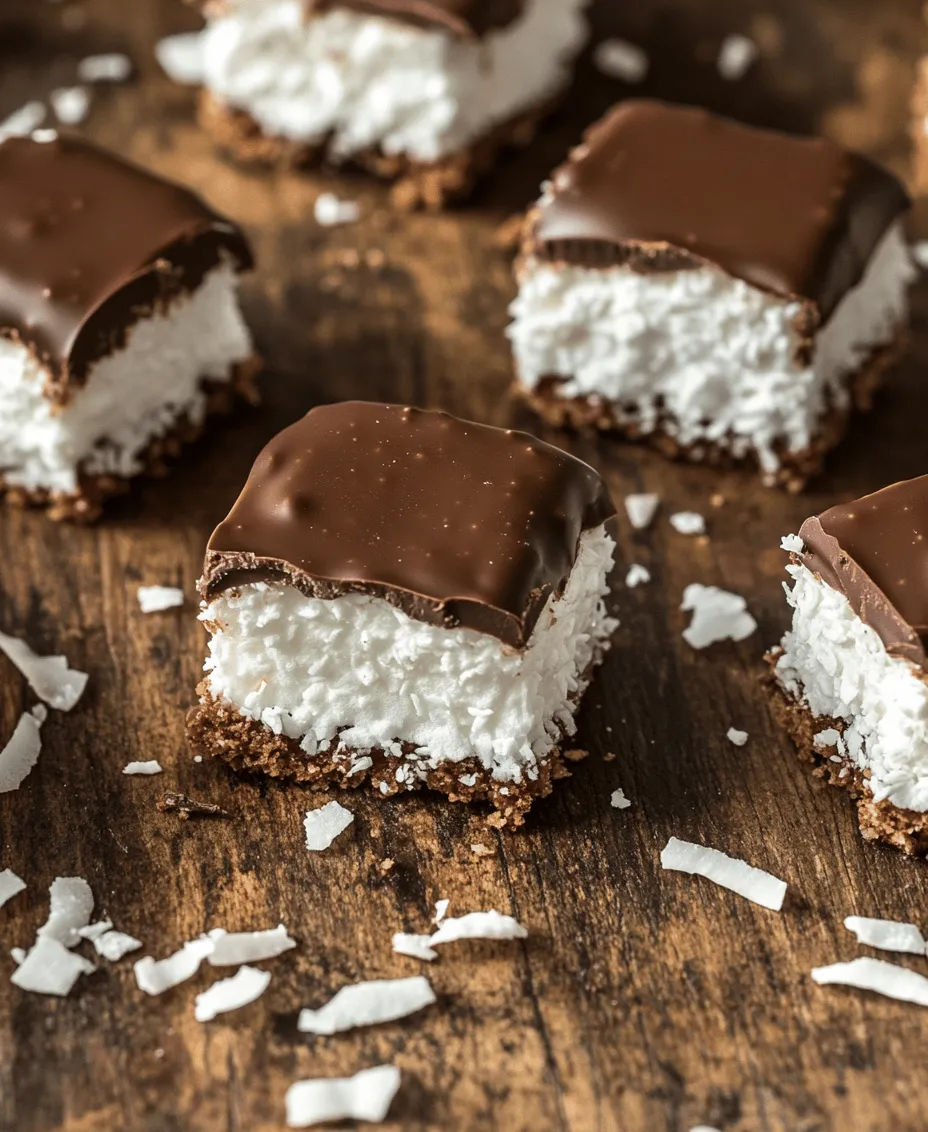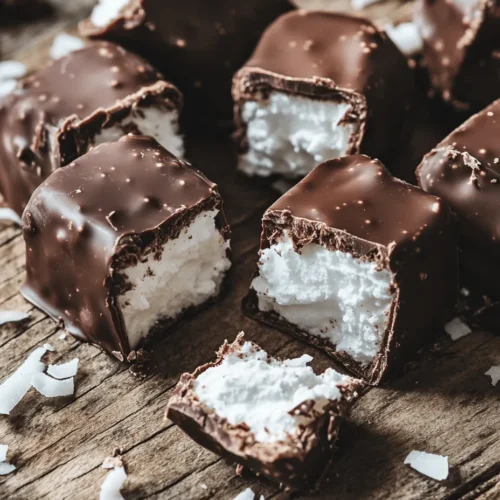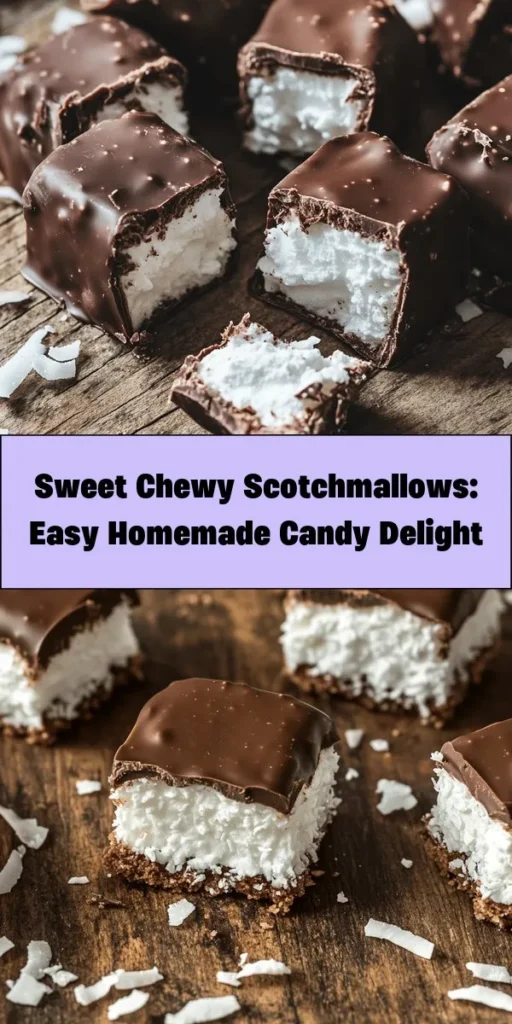Introduction
Scotchmallows are a delightful, nostalgic treat that many people hold dear to their hearts. These charming confections combine the airy sweetness of marshmallows with the rich, satisfying flavor of chocolate and the tropical essence of coconut. Each bite delivers a perfect balance of chewy and crunchy textures, making Scotchmallows a favorite not just for children but also for adults who enjoy a taste of their childhood.
What makes this Scotchmallows recipe particularly appealing is its simplicity. Even if you’re not a seasoned baker, you can whip up a batch of these treats in no time. The recipe requires minimal ingredients and offers straightforward steps, making it accessible for all skill levels. Whether you’re looking to impress your family, share a sweet gift with friends, or just indulge in a homemade dessert, this easy Scotchmallows recipe has got you covered.
Understanding Scotchmallows
Definition and History of Scotchmallows
Scotchmallows are a unique candy that merges two beloved treats: marshmallows and chocolate. The origins of Scotchmallows can be traced back to the mid-20th century, where they gained popularity primarily in North America. These candies were often found in local shops and bakeries, capturing the attention of candy lovers with their sweet flavor and delightful texture.
The name “Scotchmallow” itself is believed to derive from the combination of “Scotch,” which may refer to the Scottish influence in candy-making, and “marshmallow,” highlighting the primary ingredient in this treat. Over the years, Scotchmallows have evolved, with variations appearing in different regions, but the basic structure remains the same: a chewy layer of marshmallow, coated with chocolate and sprinkled with coconut.
Popularity Across Regions
Scotchmallows have cultivated a loyal following among candy enthusiasts of all ages. Whether it’s during the holidays, at birthday parties, or simply as a sweet indulgence, these treats never seem to lose their charm. Their versatility allows them to be enjoyed year-round, making them a staple in many households.
In some regions, Scotchmallows are considered a classic treat synonymous with nostalgia, often evoking memories of simpler times spent enjoying homemade candies. For others, the experience of making Scotchmallows from scratch can be an exciting adventure, allowing families to bond over the candy-making process.
Homemade Versus Store-Bought
While store-bought Scotchmallows can be convenient, many candy lovers argue that homemade versions offer a superior taste and experience. Homemade Scotchmallows allow for customization in terms of flavor and texture, enabling you to adjust the sweetness or chocolate coating to your preference. Additionally, making these treats at home can be a fulfilling activity that brings joy to both the maker and the recipient.
By preparing Scotchmallows in your own kitchen, you can also ensure high-quality ingredients, resulting in a purer taste. The simplicity of this recipe means that you can enjoy the process without the need for complex equipment or techniques, making homemade Scotchmallows a rewarding endeavor for anyone looking to satisfy their sweet tooth.
Ingredients Breakdown
To create the perfect Scotchmallows, you’ll need a few key ingredients. Each component plays a vital role in achieving that classic chewy texture and indulgent flavor. Here’s a closer look at the essential ingredients:
Granulated Sugar, Corn Syrup, and Water
The foundation of any candy recipe starts with sugar. In this case, granulated sugar is essential for creating the chewy marshmallow base. When combined with corn syrup and water, these ingredients help achieve the right consistency for your Scotchmallows.
Corn syrup serves a dual purpose: it helps prevent the sugar from crystallizing during the cooking process, ensuring a smooth texture, and it adds a touch of sweetness. Monitoring the sugar mixture is critical, as achieving the correct temperature is necessary for the soft ball stage, which will ultimately determine the texture of your Scotchmallows.
Marshmallow Crème
Marshmallow crème is a key player in this recipe, providing the fluffy, chewy texture that is synonymous with Scotchmallows. It acts as a binder for the other ingredients, ensuring that everything holds together beautifully. Using marshmallow crème simplifies the candy-making process, allowing you to skip the step of making marshmallows from scratch.
Unsweetened Shredded Coconut
The addition of unsweetened shredded coconut elevates the flavor profile of your Scotchmallows. The coconut adds a delightful chewiness and a hint of tropical flavor that complements the sweetness of the marshmallow and chocolate. Opting for unsweetened coconut helps to balance the overall sweetness of the candy, allowing the other flavors to shine through.
Chocolate Chips
For the chocolate coating, semi-sweet chocolate chips are typically preferred. Semi-sweet chocolate strikes the right balance between sweetness and richness, enhancing the overall taste of the Scotchmallows. The chocolate not only adds flavor but also creates a sumptuous outer layer that contrasts beautifully with the chewy interior.
Vegetable Oil
Finally, a small amount of vegetable oil is used in the chocolate coating. This ingredient serves to thin the chocolate, making it easier to coat the Scotchmallows evenly. The oil also helps to create a glossy finish, giving your finished treats a professional appearance.
Preparation Steps
Preparing the Pan
Before diving into the candy-making process, it’s crucial to prepare your pan properly. Line an 8×8-inch baking dish with parchment paper, allowing for some overhang on the sides. This step is essential for easy removal of the Scotchmallows once they have set. The parchment paper prevents sticking and ensures that you can lift the entire batch out of the pan with minimal effort, making cutting and serving a breeze.
Making the Caramel
Now, it’s time to start making the caramel base for your Scotchmallows. In a medium saucepan, combine granulated sugar, corn syrup, and water. Place the saucepan over medium heat and stir the mixture gently until the sugar is fully dissolved. Once dissolved, stop stirring to allow the mixture to come to a boil.
As the caramel cooks, it’s vital to monitor the temperature closely. You’ll want to bring it to the soft ball stage, which is typically around 235°F to 240°F (113°C to 115°C). This temperature is crucial for achieving the right consistency, so it’s recommended to use a candy thermometer for precision.
Understanding the Soft Ball Stage
The soft ball stage is a critical point in candy-making where the sugar syrup has reached the perfect consistency. To test for this stage without a thermometer, you can drop a small amount of the syrup into a glass of cold water. If it forms a soft ball that flattens when removed, you’ve reached the desired temperature.
It’s important to be vigilant during this process, as sugar can quickly go from undercooked to overcooked. If the mixture cooks too long, it will become too hard, resulting in a candy that’s difficult to chew once cooled.
Tips for Monitoring Temperature
To avoid burning the sugar mixture, make sure to keep the heat at a medium setting. If you notice the sugar starting to darken too quickly, you may want to adjust the heat lower. Also, swirling the pan gently can help distribute the heat evenly without introducing too much air into the mixture.
By following these steps and tips, you’re well on your way to creating a delightful batch of Scotchmallows that will impress friends and family alike. With the right ingredients and careful attention to detail, you can master this nostalgic treat from the comfort of your own kitchen.
Stay tuned for the next part of this article, where we will delve into the remaining preparation steps and offer additional tips for achieving the best results with your Scotchmallows.

Incorporating Marshmallow Crème: How to Achieve a Smooth Mixture
The key to achieving that delightful, chewy texture in your Scotchmallows lies in how well you incorporate the marshmallow crème into your mixture. Begin by ensuring that your marshmallow crème is at room temperature; this will make it easier to blend. If you’ve just taken it out of the refrigerator, consider microwaving it for about 10 seconds to soften it slightly.
In a large mixing bowl, combine the marshmallow crème with your sugar mixture (made from sugar, corn syrup, and water) until fully blended. Use a spatula or a wooden spoon to fold the mixture gently, ensuring that you don’t deflate the air incorporated into the marshmallow. The goal is to achieve a smooth, cohesive mixture that’s well combined but still airy.
Mixing in Coconut: Tips for Even Distribution
Once your marshmallow crème is beautifully blended, it’s time to fold in the shredded coconut. This step is crucial as it adds texture and a delightful tropical flavor to your Scotchmallows. For the best results, use unsweetened shredded coconut to avoid overpowering the sweetness of the marshmallow.
Begin by adding half of the coconut to your marshmallow mixture and gently fold it in. Be careful not to stir too vigorously, as this can deflate the mixture. Once the first batch of coconut is incorporated, add the remaining coconut and repeat the folding process. The aim is to achieve an even distribution of coconut throughout the mixture, creating a delightful mouthfeel in every bite.
Pouring into the Pan: Techniques for Spreading the Mixture Evenly
With your mixture complete, it’s time to pour it into the prepared pan. Start by greasing the pan lightly with cooking spray or butter to ensure easy removal later. Use a spatula to scoop the mixture into the pan, and then gently spread it out into an even layer.
To achieve a perfectly level surface, consider using a second spatula or a piece of parchment paper to press down the mixture. This method not only helps in leveling but also reduces the stickiness of the mixture on the spatula. Ensure that the mixture is uniformly spread to allow for even cooling and setting. Once leveled, let the Scotchmallow mixture cool at room temperature for about 2-3 hours, or until set.
Creating the Chocolate Coating
The chocolate coating is what truly elevates the Scotchmallows. It’s essential to use high-quality chocolate for melting, as this will affect the flavor and texture of your final product.
Importance of the Right Melting Technique for Chocolate
When melting chocolate, the technique you choose can significantly impact the outcome. Chocolate is sensitive to heat, so it’s vital to melt it slowly to avoid burning. Whether you opt for a microwave or a double boiler, patience is key.
Using a Microwave Versus a Double Boiler: Pros and Cons
Microwave Method: This method is quicker. Place your chopped chocolate in a microwave-safe bowl and heat it in 30-second intervals, stirring in between until fully melted. However, be cautious as microwaves can heat unevenly, leading to potential scorching.
Double Boiler Method: This method is more controlled. Fill a pot with water and place a heatproof bowl on top, ensuring it doesn’t touch the water. Heat the water to a simmer and stir the chocolate in the bowl until melted. While this method takes longer, it allows for more even melting and reduces the risk of overheating.
Achieving the Perfect Consistency with Chocolate and Vegetable Oil
To ensure a smooth and shiny chocolate coating, consider adding a teaspoon of vegetable oil to your melted chocolate. This not only helps create a glossy finish but also provides a slight flexibility that prevents the chocolate from cracking when set. Stir the oil in after the chocolate is melted and fully combined, ensuring a consistent texture.
Cutting and Coating Your Scotchmallows
Now that your Scotchmallows are set and the chocolate is ready, it’s time to cut and coat your treats.
Best Practices for Cutting Scotchmallows into Uniform Pieces
Using a sharp knife is essential for cutting your Scotchmallows into uniform pieces. To prevent sticking, warm the knife blade under hot water, then dry it before cutting. This technique helps achieve clean edges and prevents the marshmallow from adhering to the knife.
Cut the Scotchmallows into squares or rectangles, depending on your preference. A standard size is about 1 inch by 2 inches, but feel free to make them larger or smaller based on your serving needs.
Techniques for Dipping and Coating Without Excess Chocolate
To coat your Scotchmallows, use a fork or a dipping tool. Dip each piece into the melted chocolate, ensuring it’s fully covered. Allow the excess chocolate to drip off before placing the coated Scotchmallow on a parchment-lined baking sheet. This technique minimizes excess chocolate and creates a more appealing finish.
For a decorative touch, consider sprinkling additional shredded coconut or sea salt on top of the chocolate coating before it sets. This adds flavor and visual appeal to your treats.
Presentation Tips for Serving the Scotchmallows
When it comes to serving your Scotchmallows, presentation is key. Arrange the pieces on a decorative platter, and for a festive touch, consider garnishing with fresh mint leaves or edible flowers. For special occasions, individual servings wrapped in cellophane bags tied with ribbons can make lovely party favors.
Storage and Shelf Life
Now that you’ve made your Scotchmallows, proper storage is crucial to maintaining their freshness and texture.
Best Practices for Storing Scotchmallows to Maintain Freshness
To store your Scotchmallows, place them in an airtight container. Layer the pieces with parchment paper to prevent them from sticking together. Keep the container in a cool, dry place, away from direct sunlight and heat sources.
Shelf Life of the Treats and How to Tell if They Are Still Good to Eat
When stored correctly, Scotchmallows can last for up to two weeks. To test their freshness, look for any signs of moisture or a change in texture. If the chocolate coating appears dull or the marshmallow becomes overly sticky, it’s best to discard them.
Nutritional Information
While Scotchmallows are a delightful treat, it’s essential to consider their nutritional aspects.
Overview of the Nutritional Aspects of Scotchmallows
Each piece of Scotchmallow contains carbohydrates from the sugar and corn syrup, while the marshmallow crème and coconut provide some dietary fiber and fat. A typical piece may contain around 100 calories, depending on the size and ingredients used.
Discussion on Moderation and Enjoyment
Enjoying Scotchmallows in moderation is key. While they are a sweet indulgence, these delightful treats can be part of a balanced diet when consumed occasionally. Sharing them with friends and family can also enhance the experience, turning a simple treat into a cherished moment.
Conclusion
Making Scotchmallows is not just about creating a delicious treat; it’s about the joy of crafting something special to share with loved ones. The combination of chewy marshmallow, crunchy coconut, and rich chocolate creates a delightful experience that’s hard to resist.
I encourage you to try this recipe at home, allowing yourself to enjoy the magical process of creating these sweet bites. Whether you serve them at a celebration or enjoy them during a quiet evening at home, homemade Scotchmallows are sure to bring smiles to the faces of those who indulge. Remember, the timeless nature of homemade sweets has a special place in our hearts and celebrations, making every moment just a little bit sweeter.



